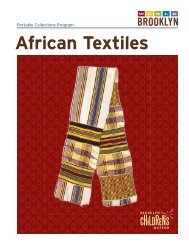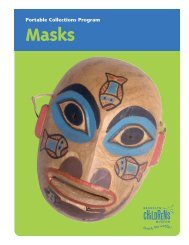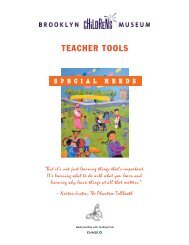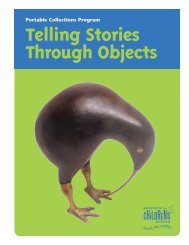Chinese New Year - Brooklyn Children's Museum
Chinese New Year - Brooklyn Children's Museum
Chinese New Year - Brooklyn Children's Museum
You also want an ePaper? Increase the reach of your titles
YUMPU automatically turns print PDFs into web optimized ePapers that Google loves.
information for the teacher<br />
Information About Objects In The Case<br />
Hong Bao Red paper envelopes filled with gifts of money. On <strong>Chinese</strong> <strong>New</strong><br />
<strong>Year</strong>, adults give hong bao to children. Designs on the hong bao range from<br />
the traditional to popular cartoon characters but all are meant to invite good<br />
fortune. Symbols include the <strong>Chinese</strong> zodiac animal of the year, fish, oranges,<br />
and flowers. The amount of money in the envelope is always an even number,<br />
as odd numbers are associated with cash given during funerals. The number<br />
eight is considered lucky since the word “eight” sounds similar to the word<br />
“wealth.” $8 is a common gift amount.<br />
Tangerine Tree Tangerines and oranges are frequently displayed in homes<br />
and stores. Tangerines symbolize good luck, and oranges are symbols of<br />
wealth. These meanings have developed through a language pun, the word<br />
for tangerine having the same sound as “luck” in <strong>Chinese</strong>, and the word for<br />
orange having the same sound as “wealth”.<br />
Fu Sign “Fu” is the <strong>Chinese</strong> word for “good luck”. Diamond shaped paper<br />
signs with Fu written in <strong>Chinese</strong> calligraphy are popular decorations for the<br />
<strong>New</strong> <strong>Year</strong>. The signs are hung so the word, Fu, is upside down. The <strong>Chinese</strong><br />
word for “upside-down” rhymes with the <strong>Chinese</strong> word for “arrive.” So when<br />
the sign is hung upside-down it wishes good luck to arrive soon!<br />
Decorative Firecrackers Decorations in the shape of firecrackers festoon<br />
homes and stores during the <strong>New</strong> <strong>Year</strong> season. Actual firecrackers are part<br />
of every <strong>Chinese</strong> <strong>New</strong> <strong>Year</strong>. There is a belief that the noise of the fireworks is<br />
supposed to scare away all evil spirits and misfortunes, preventing them from<br />
coming into the <strong>New</strong> <strong>Year</strong>.<br />
Boy and Girl Lantern Red lanterns featuring <strong>New</strong> <strong>Year</strong>’s symbols decorate<br />
stores, homes, and streets during the <strong>Chinese</strong> <strong>New</strong> <strong>Year</strong> season. They are<br />
especially important on the fifteenth day of the <strong>Chinese</strong> <strong>New</strong> <strong>Year</strong> when the<br />
Lantern festival celebrates the first full moon of the year. This lantern features<br />
a boy and girl, a common motif for <strong>New</strong> <strong>Year</strong> as children are good luck<br />
because they represent the future.<br />
Lion Head The lion dance is an important tradition in <strong>Chinese</strong> culture.<br />
Usually the dance is part of festivities like <strong>Chinese</strong> <strong>New</strong> <strong>Year</strong>, the openings of<br />
restaurants, and weddings. A well-performed lion dance is believed to bring<br />
luck and happiness. The “lion” is brought to life by two dancers. One moves the<br />
head, which is made out of strong but light materials like papier-mâché and<br />
bamboo, the other plays the body and the tail under a bright cloth that is<br />
attached to the head.<br />
<strong>Chinese</strong> <strong>New</strong> <strong>Year</strong> | 10








